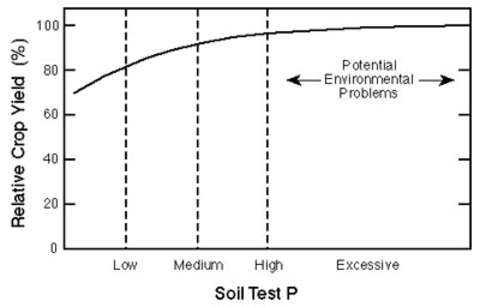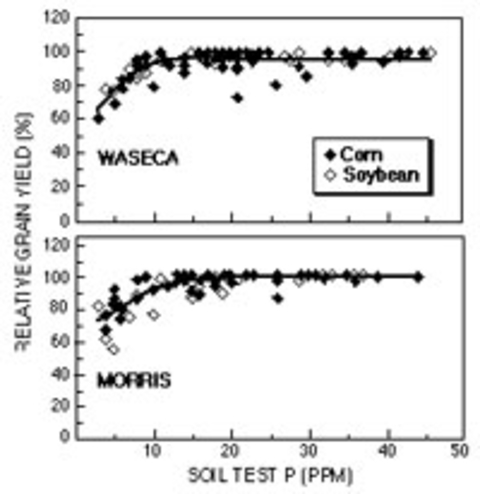Quick facts
- Use conservation tillage systems to reduce the amount of soil lost by erosion.
- Band or inject phosphate fertilizers and manure below the soil surface.
- Monitor soil test levels for phosphorus. There’s no reason to build soil test levels above 20 parts per million (ppm) using the Bray test or 16 ppm using the Olsen test.
Managing phosphorus for crop production
Managing phosphorus inputs for crop production systems is a very important task, but it doesn’t have to be a complicated one.
Here, we’ll describe management practices and how they affect phosphorus losses.
Generally, management practices that reduce the potential for environmental contamination also help minimize costs:
-
Use conservation tillage systems to reduce the amount of soil lost by erosion.
-
Band or inject phosphate fertilizers and manure below the soil surface.
-
Monitor soil test levels for phosphorus. It’s not necessary to build these levels above 20 parts per million (ppm) using the Bray test or 16 ppm using the Olsen test.
Environmental impact
The relationships between nutrient management and environmental quality is an area of concern. In the late 1980s and early 1990s, people involved with agriculture focused their attention on the environmental impacts of nitrogen applied in fertilizers and manures.
More recently, attention has shifted to the effect of phosphorus management on water quality in lakes and rivers.
Ample evidence shows that algal growth in surface waters is directly related to concentrations of nitrogen and phosphorus. This is why the amount of phosphorus that enters surface waters has received special attention.
How to control phosphorus losses
Research efforts throughout the United States have focused on developing management practices to control the loss of phosphorus from the agricultural landscape.
In general, phosphorus losses are affected by:
-
Crop grown.
-
Tillage systems.
-
Rate, time and method of applying inorganic and organic sources of phosphorus.
-
Soil test level for phosphorus.
The selected crop can have a substantial effect on phosphorus loss. Table 1 lists examples of measured losses from various cropped landscapes.
When measuring losses, both the water and sediment are analyzed for phosphorus. Phosphorus found in the water is described as soluble, while the amount attached to soil particles is referred to as sediment phosphorus.
We’ve added both components together to calculate the total amount of phosphorus lost from the landscape.
Table 1: Phosphorus losses from various landscapes
| Land use | Soluble phosphorus loss | Sediment phosphorus loss | Total phosphorus loss |
|---|---|---|---|
| Grass | 0.45 lbs. per acre | 6.60 lbs. per acre | 7.05 lbs. per acre |
| No-till corn | 0.98 lbs. per acre | 1.90 lbs. per acre | 2.94 lbs. per acre |
| Conventional corn | 0.27 lbs. per acre | 13.48 lbs. per acre | 13.75 lbs. per acre |
| Wheat/summer fallow | 0.18 lbs. per acre | 1.25 lbs. per acre | 1.43 lbs. per acre |
We used summaries from a variety of research projects to list the losses in Table 1. Losses can be rather small, such as with a wheat/summer fallow cropping system, or substantial, such as with a conventional corn cropping system.
You’ll see that most of the lost phosphorus is attached to soil particles. So, any cropping system that reduces soil erosion will reduce the loss of phosphorus from the landscape.
Several research projects have focused on how tillage systems affect the loss of phosphorus from the landscape.
Typical losses
Because research projects use different procedures, actual measured losses vary with each study. The results summarized in Table 2 are typical of those found in many studies.
Table 2: The effect of tillage system with and without the broadcast application of phosphate fertilizer on phosphorus loss
| Tillage system | Phosphate Use | Soluble phosphorus loss Sediment phosphorus loss | Sediment phosphorus loss | Total phosphorus loss |
|---|---|---|---|---|
| Ridge-till | Yes | .061 lbs. per acre | 4.09 lbs. per acre | 4.15 lbs. per acre |
| Ridge-till | No | .005 lbs. per acre | 2.96 lbs. per acre | 2.97 lbs. per acre |
| Conventional | Yes | .003 lbs. per acre | 10.01 lbs. per acre | 10.01 lbs. per acre |
| Conventional | No | .001 lbs. per acre | 6.69 lbs. per acre | 6.69 lbs. per acre |
P2O5 rate = 115 pounds per acre. Source: Romkins et al.
To reduce total phosphorus loss, use a conservation tillage production system, like ridge-till. Conservation tillage production systems reduce soil loss, so any major reductions in phosphorus losses happen because producers are losing less sediment.
Effect on yield
In Minnesota, the ridge-till planting system is an excellent choice for controlling soil erosion.
Yields of corn and soybeans grown in this planting system have been comparable to yields of these crops grown in the more conventional moldboard plow system (Table 3).
The need for planting systems that control soil erosion changes with the varied landscapes of Minnesota. When erosion control is needed, the ridge-till planting system is well-suited for the soils and climate of Minnesota.
Table 3: The effect of tillage system on corn and soybean yields in Minnesota
| Location | Crop | Moldboard plow | Ridge-till |
|---|---|---|---|
| Morris | corn | 137.0 bushels per acre | 138.0 bushels per acre |
| Morris | soybeans | 43.7 bushels per acre | 44.2 bushels per acre |
| Lamberton | corn | 133.0 bushels per acre | 134.0 bushels per acre |
| Lamberton | soybeans | 40.7 bushels per acre | 41.0 bushels per acre |
| Waseca | soybeans | 42.4 bushels per acre | 41.0 bushels per acre |
| Source: Randall et al. |
If the majority of phosphorus lost from the landscape is attached to soil particles, you can reasonably expect that the method of applying phosphate fertilizers and manures can substantially impact phosphorus loss.
Typical losses
Research projects have clearly demonstrated that phosphorus loss is strongly affected by how phosphorus sources are applied. Results from a study conducted in Virginia typify several other research project summaries (Table 4).
In Minnesota planting systems, appropriate practices for applying phosphate via subsurface injection include using a deep band applied in the fall before planting, or a starter fertilizer applied at planting.
When phosphate fertilizers are broadcast on the soil surface and incorporated, some phosphorus is left either at or close to the soil surface. Erosion can remove this phosphorus.
You’re less likely to lose phosphorus if you apply phosphate fertilizers in a band below the soil surface. The same reasoning applies to manure applications.
Table 4: How the method of applying phosphate fertilizer in two tillage systems affected phosphorus loss
| Tillage system | Phosphate* placement | Total phosphorus (P) loss |
|---|---|---|
| No-till | None applied | 0.10 lbs. of P per acre |
| No-till | Subsurface injection | 0.24 lbs. of P per acre |
| No-till | Surface broadcast | 0.53 lbs. of P per acre |
| Conventional | None applied | 1.91 lbs. of P per acre |
| Conventional | Subsurface injection | 2.58 lbs. of P per acre |
| Conventional | Surface broadcast | 4.71 lbs. of P per acre |
| *P2O5 rate = 94 pounds per acre. Source: Mostaghimi et al. |
Effect on yield
Applying phosphate fertilizer in a band has not reduced corn yields in Minnesota. Results of several research projects have shown that producers can reduce the rates of phosphate needed for optimum production if they apply fertilizer in a band rather than broadcasting and incorporating it before planting.
The results from a study conducted in Lamberton are similar to results from other studies (Table 5).
In general, recommended phosphate rates can be cut in half if you apply it in a band rather than broadcasting and incorporating it before planting. Banded applications of phosphate fertilizer are also more cost-effective and better for the environment.
Table 5: How the amount and placement of phosphate fertilizer affects corn yield in Lamberton
| P2O5 applied | Placement | Grain yield |
|---|---|---|
| 0 lbs. per acre | -- | 126.1 bushels per acre |
| 40 lbs. per acre | Starter | 143.6 bushels per acre |
| 200 lbs. per acre | Broadcast | 143.8 bushels per acre |
| Soil test P = 6 ppm (low) |
Producers usually test for phosphorus in soils to predict how much phosphate a fertilizer or manure program needs for optimal yield.
Crop yields decrease as the phosphorus soil test level drops into the medium range and below (Figure 1).
The potential for environmental problems increases as soil test levels move into the high range. An increase in phosphorus soil test levels indicates a larger amount of phosphorus in the root zone. Higher amounts present in the soil increase the potential for loss.
How to measure
In Minnesota, soil test levels are measured in a laboratory by either the Bray or Olsen procedure. The Bray procedure is usually used when soil pH is less than 7.4. Use the Olsen procedure when soil pH is 7.4 or higher.
Table 6 lists the phosphorus soil test values that correspond to the relative levels.
Table 6: Definition of soil test values for phosphorus as measured by the Bray and Olsen procedures
| Relative level | Bray procedure | Olsen procedure |
|---|---|---|
| very low | 0-5 ppm | 0-3 ppm |
| low | 6-10 ppm | 4-7 ppm |
| medium | 11-15 ppm | 8-11 ppm |
| high | 16-20 ppm | 12-15 ppm |
| very high | 21+ ppm | 16+ ppm |
Impact on yield
In general, phosphorus supplied either in fertilizer or manure will not increase crop yields if soil test levels for phosphorus are in the high range and above. A years-long research project showed yields did not increase when the Bray soil test for phosphorus exceeded about 13 ppm in Waseca and 19 ppm in Morris.
Ultimately, there’s no economic justification for building soil test phosphorus levels above 20 ppm, as measured by the Bray procedure, or 16 ppm and higher, as measured by the Olsen test.
Soil test levels will increase when the amounts of phosphorus added to the soil as either fertilizer or manure are higher than amounts removed by crop. When using manure is a consistent component of the farm enterprise, soil testing for phosphorus should be a routine management practice
Likewise, applying phosphate fertilizer for crop production, when the soil test for phosphorus is 20 ppm or higher, does not increase yield. These additions simply increase the potential for loss of phosphorus from the landscape.
Reviewed in 2018



